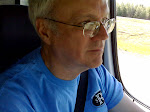When planning our trip a visit to Stirling headed my list of “must-sees”. For decades I’ve admired William Wallace, whose victory over King Edward I’s invading army at the Battle of Stirling Bridge lit the fuse of Scottish nationalism. So the day after we had gone to the Cairngorm Mountains and ridden a funicular railway to the top (pictures were in my last post), and driven back to our lodging via the road along Loch Ness [note to self: Loch Ness was a non-event. Seeing it was a “Welcome to Lake Champlain” moment - pleasant but not worth crossing an ocean for. The Scottish Highlands are absolutely stunning. Without a gimmick, Loch Ness would not attract much interest], we headed south to Stirling. We visited the William Wallace Monument that appears to have come straight out of a J. R. R. Tolkien novel. I had read that Wallace was a large man for his time (late 13th century), but when I saw his sword I realized just how large he must have been. A marvelous docent at the Monument, dressed as one of Wallace’s warriors, explained what it was like to campaign with him. It is significant that Wallace’s warriors fought not for glory or money [note to self: be sure to tell the Pentagon that they should seek real patriots to recruit rather than hiring Blackwater mercenaries] but rather for the idea of a community of people called Scotland. The spirit Wallace nurtured culminated in the Declaration of Arbroath in 1320: “. . . for so long as there shall but one hundred of us remain alive we will never subject ourselves to the dominion of the English. For it is not glory, it is not riches, neither is it honour, but it is Liberty alone that we fight and contend for, which no honest man will lose but with his life.” Tom Paine couldn't have said it any better!
This morning we visited Stirling Castle, and this afternoon the Falkirk Wheel. Stirling Castle, sitting high above the main crossing of the River Forth. The original fortifications were built on the site of a mid-first Millennium chapel. James the IV initiated one cycle of construction, James V did major building. James VI was baptized there and departed to become James I of England (James I was the first to use the term "Great Britain" to verbally assert the union of England and Scotland). Mary Queen of Scots was crowned at Stirling. It figured in numerous conflicts, including Bonnie Prince Charlie's attempt to regain the throne, failing in his attempt to capture Stirling Castle.
The Falkirk Wheel was completed in 2002 in order to re-connect the Forth and Clyde Canal with the Union Canal. Rather than rebuild 11 locks that would have taken a day to negotiate, they built this marvelous rotating wheel that moves boats, floating in enormous tubs of water, from one canal to the other in five and a half minutes. Whilst watching the Wheel turn I enjoyed an Irn Bru (pronounced “Iron Brew” and brewed for over 100 years in Glasgow), as national a soft drink for Scotland as Coke is to the U. S. [note to self: Irn Bru tastes like Double Bubble bubble gum, and might catch on for gum chewers who are too lazy to chew].
We had dinner this evening in at a small bistro, the Espy, on the esplanade on the Portobello beach. Vanessa, the hostess, asserted that they had the best sticky toffee pudding in the world. Having previously decided that the sticky toffee pudding at the Queens Hotel in Lockerbie [note to self: remember that this was the place where you had your first sticky toffee pudding] was the best in the universe, we accepted the challenge and tried theirs. You can see by the expression on Jane’s face as she savored the last bite, that it was indeed delicious. We awarded the Espy sticky toffee pudding a tie with that from the Queens Hotel. Vanessa was thrilled with the news. Ah, the excitement of it all!














No comments:
Post a Comment